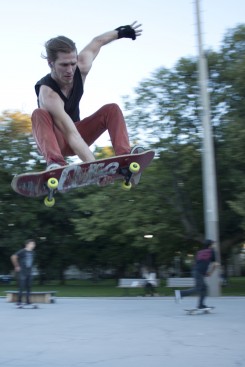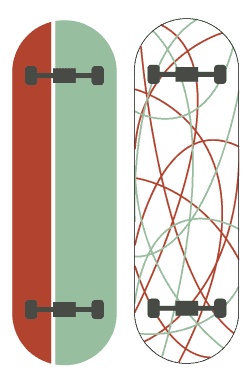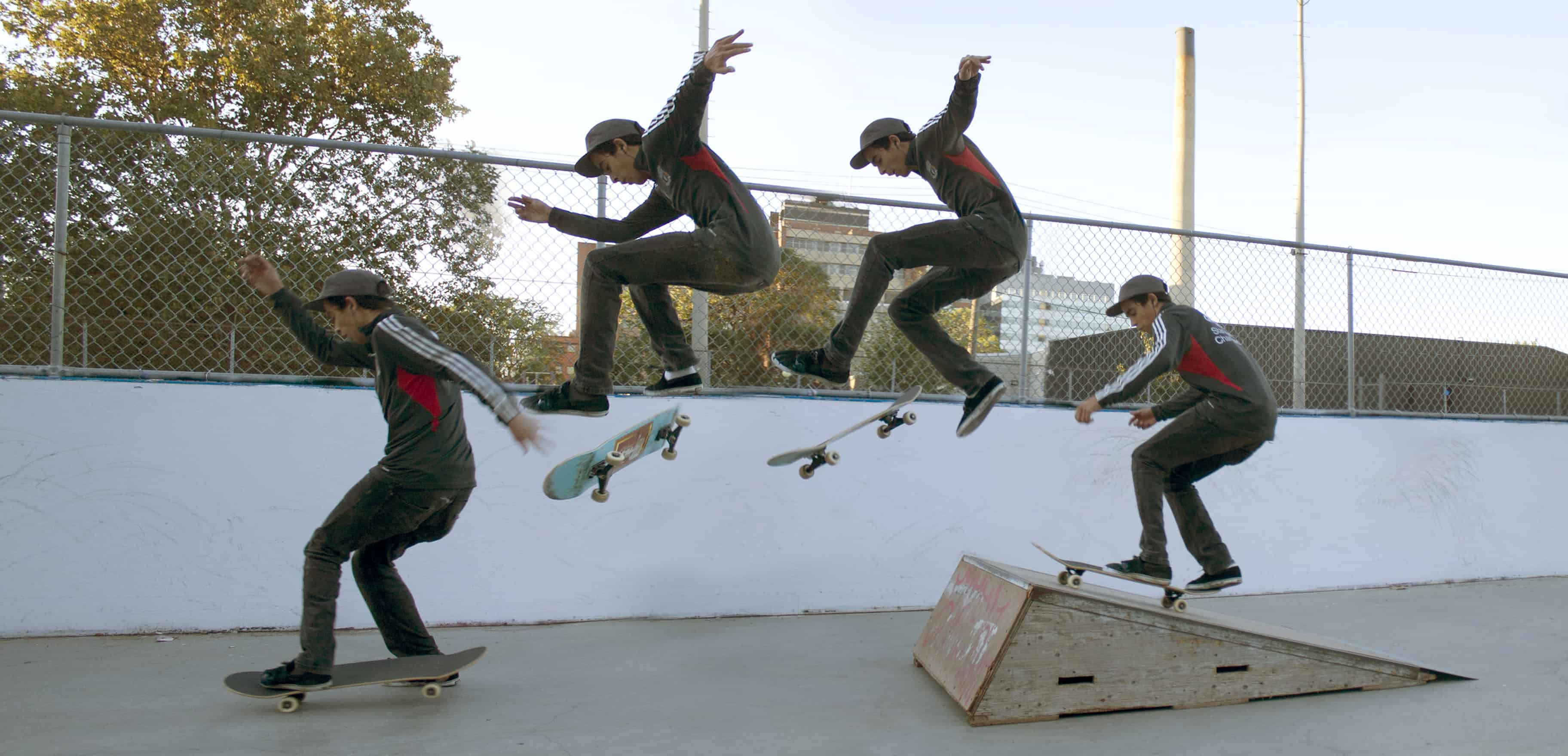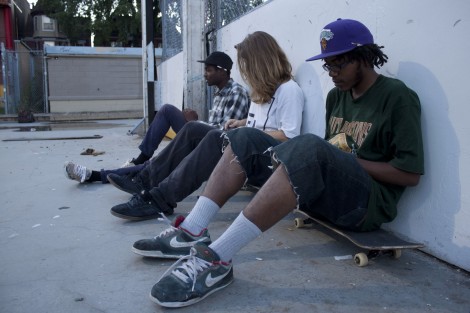Five guys startle a pedestrian on the northeast corner of Dundas and Bathurst as they push past; each has one foot against the ground of Toronto’s urban playground, and the other on the most worshipped plank of wood created by post-World War II consumer society: a skateboard. This scene is typical of the Toronto skateboarding experience, taking place at Toronto’s skateboarding hub: the temporary park known as “Dunbat.” It’s a crowded junction, where passersby must navigate a constant stream of skaters.
The park, which functions as an ice rink during winter, consists of an ensemble of wooden boxes and ledges: two mini-ramps, half-pipes to laymen, though smaller and less vertical than the kind ridden by Tony Hawk; some metal flat-bars — rails standing about a foot off the ground; countless beer cans; a teeming crew of skaters. Those who frequent the park are associated by either a real camaraderie or, at least, the common passion for the art of skateboarding. Skaters meet and warm up on the rectangular prism-shaped wooden ledge and smooth flat concrete before turning to the harsher expanse of urban playground in Toronto’s downtown core. Once there, they can film their interactions with that familiar landscape and share them with the larger skateboarding community.
 The experiences of Toronto skaters, however, are fundamentally diverse. Although there are many shared traits between skaters — such as language and dress — any skateboarding community is first and foremost a community of individuals. Rob Mentov, creator of Street Feet, explains: “I don’t think there’s one style that defines Toronto at all.” Street Feet is a loosely-defined skateboarding video production label in Toronto — assembled, according to Mentov, by “whoever is interested in skateboarding in the city…[and] who want to show the city in a good light, especially people who are overlooked in the city.”
The experiences of Toronto skaters, however, are fundamentally diverse. Although there are many shared traits between skaters — such as language and dress — any skateboarding community is first and foremost a community of individuals. Rob Mentov, creator of Street Feet, explains: “I don’t think there’s one style that defines Toronto at all.” Street Feet is a loosely-defined skateboarding video production label in Toronto — assembled, according to Mentov, by “whoever is interested in skateboarding in the city…[and] who want to show the city in a good light, especially people who are overlooked in the city.”
Mentov asserts that Dunbat is not necessarily reflective of skateboarding in general, and Toronto skate culture in particular, noting: “It’s more of a social gathering than an act of skating.” Dunbat is as much a clubhouse for drinking beer and shooting the shit as it is a place for skateboarding sessions. Toronto skating is defined by the city’s vast terrain and those who explore it.
Exodus Downtown
Blue Tile Lounge’s video presentation, Fistful of Loonies.
No definition of Toronto skateboarding is clear-cut. In discussing Toronto’s all-time top five skaters, Rob Lane, owner and operator of Blue Tile Lounge — a skateboard shop on College — Supra Distribution representative Sean Mo, and local skater Andrew Huckendorf all disagreed. The three were unsure whether to include former professional Corey Sheppard on the list because he was from “the suburbs,” but eventually counted him in. When Mo brought up Toronto legend Tom Boyle, Lane replied: “No…I just don’t consider him from here…he’s from Pennsylvania.”
Referring to his store’s origins in Aurora and Newmarket and the limitations he experienced in those locations, Lane mused: “That’s the one thing I’ve liked and hated about Toronto… In the past it’s been like, you guys are doing good… we want to give you opportunity, but you’re just not in the city.”
There doesn’t seem to be a stable definition for a Toronto skater, as there remains no textbook on what makes one type of skateboarding or skateboarder the legitimate brand of identity. Who’s more of a Toronto skater: the guy from outside of Toronto proper who skates every spot in the city harder than anyone else, or the guy born and bred here who has made less of a mark?
In the end, it may not matter. Lane remarked: “Most people move downtown eventually. The suburb thing gets kind of boring.” The frequency of social and cultural activity in the downtown core of Toronto, rather than in its peripheries, comes to be identified as authentic at the expense of what happens in the suburbs. More skaters end up moving in from the suburbs, melt in with those from Toronto proper, and form a larger community where geographical origins are forgotten. Any survey of Toronto’s current community would see a large demographic mix including skaters bred in Oshawa, Newmarket, Aurora, Richmond Hill, Hamilton, and other outlying municipalities. As every skater proves, it doesn’t matter where you’re from, as long as you continue to put your mark on Toronto’s urban core. After all, It’s exactly this geographic consolidation that moved the Blue Tile Lounge from Newmarket to Toronto.
Local History
Street Feet production “Equinox,” directed by Rob Mentov, featuring skaters navigating Toronto’s cold winter.
The clearest motive to relocate downtown is the experience of a day spent skating spot-to-spot throughout the core. There isn’t necessarily any set routine for how this plays out; the act of skateboarding is as diverse as the perspectives of all skaters who become involved. As different skaters come to form Toronto’s community, their creative processes come to interpret potential acts of skateboarding within the city differently. They will attempt to apply their imaginations to reality by trying out tricks and moves, sometimes landing them, and eventually build something of a cultural canon as skaters recall what has been done at each spot downtown.
 Every skater’s perception thus becomes oriented around a series of reference points as they come to identify familiar “skate spots” and recall the various maneuvers that have been accomplished there. For example, the CBC building downtown has a plaza containing marble and granite ledges that are arranged in an unorthodox pattern. Two ledges sit opposite each other with a curve cut through them, as if to make them fit together as a square. These two sit in between four L-shaped ledges at each corner of the square, while some other ledges lay around the perimeter of the plaza. No authoritative record of exactly what moves have been landed at CBC exists, so any description of how the spot has been skated cannot be definitive. However, if one were to delve into footage of how the spot was skated ten years ago, most of what would be seen involved more technical flip tricks onto the middle square, gapping the middle curve, and landing in a manual (a sustained wheelie) on the second ledge before dropping off it and riding away. For this type of skating, one could watch Toronto’s 2005 video, “Environment.”
Every skater’s perception thus becomes oriented around a series of reference points as they come to identify familiar “skate spots” and recall the various maneuvers that have been accomplished there. For example, the CBC building downtown has a plaza containing marble and granite ledges that are arranged in an unorthodox pattern. Two ledges sit opposite each other with a curve cut through them, as if to make them fit together as a square. These two sit in between four L-shaped ledges at each corner of the square, while some other ledges lay around the perimeter of the plaza. No authoritative record of exactly what moves have been landed at CBC exists, so any description of how the spot has been skated cannot be definitive. However, if one were to delve into footage of how the spot was skated ten years ago, most of what would be seen involved more technical flip tricks onto the middle square, gapping the middle curve, and landing in a manual (a sustained wheelie) on the second ledge before dropping off it and riding away. For this type of skating, one could watch Toronto’s 2005 video, “Environment.”
As years went on, skaters started incorporating the outlying ledges of the plaza into lines, grinding and sliding them in succession before skating around and approaching the middle square for a manual trick. Recently, riders have skated fast at the middle square to hop onto it before trying different tricks over the outlying ledges. It was here that professional skater Jordan Hoffart innovated by gapping one of the outlying ledges onto the square before gapping from the square over the outside ledge on the other side. Local skater Cory Wozney showcased how far this maneuver could be taken this year by gapping from almost every ledge to every other ledge in seemingly impossible lines.
Different perspectives have influenced each other over time and have contributed to an evolution of ways in which any one spot is skated. Tricks and moves are filmed and shared with the community — which then builds upon itself by repeating the process. Showcasing the tricks accomplished at skate spots by sharing footage, especially online, acts as a catalyst for other community members to respond by incorporating the ideas they’ve just viewed into their own interpretations of those spots the next time they skate them. Toronto skaters also take inspiration from those in New York, Detroit, London, Paris, Tokyo, and so on, through online footage. Communities perpetuate and build upon themselves this way, making the attraction of vibrant urban centres all the more irresistible. Blue Tile’s move can be understood in the context of this expanding community. This model of community development inspires further creative interpretations, rather than exhausting them, in Toronto’s impressively large and physically accessible downtown core.
Skating Sidewalks
Street Feet production “Deconstruction,” directed by Rob Mentov, depicts Toronto skaters exploring the city’s many construction sites.
Downtown Toronto is generally a friendly place to skate, fostering a strong community, but problems remain. Perhaps most endemic to this experience is what Mentov called, “the massive disparity between how skateboarders are seen and how skaters see people.” Mentov explained this concept by relating a particular experience of his while skating the ledges behind Toronto’s courthouse: “It was super-hot out one day. My brain was heating up. I was trying to skate this ledge, but then people were walking by, and I’m getting mad at these people for walking. When you think about it, what the hell right do I have to get mad at someone for walking? It’s their basic human right… At the same time, people see skating as such a destructive thing. I don’t understand why people don’t see skating for what it really is.”
Toronto’s skateboarding scene is driven by riding in the streets. Spots provided by the city’s urban geography are skated far more than its skate parks. Unfortunately, that means pedestrian space is compromised. A lack of empathy is often the case between skaters who aggressively grind ledges, screaming at them when moves aren’t landed, and passersby. Residents of apartment complexes and property owners will often see skating as a destructive practice instead of as the creative pursuit it is to skateboarders. Skaters downtown are often kicked out of spots by security or overzealous citizens. Nevertheless, skateboarding will inevitably continue to occur at many spots frequented by people who generally dislike its presence.
 For this city’s skater community, every corner of the downtown core is seen through the lens of skateboarding’s possibilities. Skateboarding inescapably shapes their perceptions of their identity and reality. Toronto has presented itself as an inexhaustible resource for this pursuit. Despite the havoc caused by skateboarding, Toronto’s limitless downtown landscape offers much more potential to create than what has already been experienced. skaters will continue to leave their mark on the city — fostering a thriving community of performance artists who perhaps don’t always think of the collateral damage they sometimes inflict with their art. At the end of the day, accomplishing the trick imagined and pursued by dedicated skaters is just too important to sacrifice for the sake of not pissing people off.
For this city’s skater community, every corner of the downtown core is seen through the lens of skateboarding’s possibilities. Skateboarding inescapably shapes their perceptions of their identity and reality. Toronto has presented itself as an inexhaustible resource for this pursuit. Despite the havoc caused by skateboarding, Toronto’s limitless downtown landscape offers much more potential to create than what has already been experienced. skaters will continue to leave their mark on the city — fostering a thriving community of performance artists who perhaps don’t always think of the collateral damage they sometimes inflict with their art. At the end of the day, accomplishing the trick imagined and pursued by dedicated skaters is just too important to sacrifice for the sake of not pissing people off.
For more pictures from Dubat, click:




